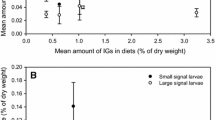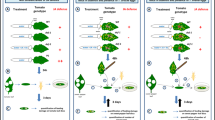Abstract
The evolution of defensive traits is driven both by benefits gained from protection against enemies and by costs of defence production. We tested the hypothesis that specialisation of herbivores on toxic host plants, accompanied by the ability to acquire plant defensive compounds for herbivore defence, is favoured by the lower costs of sequestration compared to de novo synthesis of defensive compounds. We measured physiological costs of chemical defence as a reduction in larval performance in response to repeated removal of secretions (simulating predator attack) and compared these costs between five species synthesising defences de novo and three species sequestering salicylic glucosides (SGs) from their host plants. Experiments simulating low predator pressure revealed no physiological costs in terms of survival, weight and duration of development in any of study species. However, simulation of high predation caused reduction in relative growth rate in Chrysomela lapponica larvae producing autogenous defences more frequently, than in larvae sequestering SGs. Still meta-analysis of combined data showed no overall difference in costs of autogenous and sequestered defences. However, larvae synthesising their defences de novo demonstrated secretion-conserving behaviour, produced smaller amounts of secretions, replenished them at considerably lower rates and employed other types of defences (regurgitation, evasion) more frequently when compared to sequestering larvae. These latter results provide indirect evidence for biosynthetic constraints for amounts of defensive secretions produced de novo, resulting in low defence effectiveness. Lifting these constraints by sequestration may have driven some leaf beetle lineages toward sequestration of plant allelochemicals as the main defensive strategy.





Similar content being viewed by others
References
Bernays E, Chapman R (1987) The evolution of deterrent responses in plant-feeding insects. In: Chapman RF, Bernays EA, Stoffolano JG Jr (eds) Perspectives in chemoreception and behavior. Springer, New York, pp 159–173
Bernays E, Graham M (1988) On the evolution of host specificity in phytophagous arthropods. Ecology 69:886–892
Björkman C, Larsson S (1991) Pine sawfly defense and variation in host plant resin acids: a trade-off with growth. Ecol Entomol 16:283–289
Blum MS (1981) Chemical defenses of arthropods. Academic, London
Boland W (2015) Sequestration of plant-derived glycosides by leaf beetles: a model system for evolution and adaptation. Perspect Sci 6:38–48
Bowers MD (1992) The evolution of unpalatability and the cost of chemical defense in insects. In: Roitberg BD, Isman MB (eds) Insect chemical ecology: an evolutionary approach. Chapman and Hall, New York, pp 216–244
Bowers MD (1993) Aposematic caterpillars: life styles of the warningly colored and unpalatable. In: Stamp NE, Casey TM (eds) Caterpillars: Ecological and evolutionary constraints of foraging. Chapman and Hall, London, pp 331–371
Bowers MD (2003) Host plant suitability and defensive chemistry of the catalpa sphinx, Ceratomia catalpae. J Chem Ecol 29:2359–2367
Camara MD (1997) Physiological mechanisms underlying the costs of chemical defence in Junonia coenia Hübner (Nymphalidae): a gravimetric and quantitative genetic analysis. Evol Ecol 11:451–469
Codella SG, Raffa KF (1995) Host plant influence on chemical defense in conifer sawflies (Hymenoptera: Diprionidae). Oecologia 104:1–11
Cogni R, Trigo JR, Futuyma DJ (2012) A free lunch? No cost for acquiring defensive plant pyrrolizidine alkaloids in a specialist arctiid moth (Utetheisa ornatrix). Mol Ecol 21:6152–6162
Eisner T, Eisner M, Siegler M (2007) Secret weapons: Defenses of insects, spiders, scorpions, and other many-legged creatures. Belknap, Cambridge
Engler-Chaouat HS, Gilbert LE (2007) De novo synthesis vs. sequestration: negatively correlated metabolic traits and the evolution of host plant specialization in cyanogenic butterflies. J Chem Ecol 33:25–42
Fürstenberg-Hägg J, Zagrobelny MC, Olsen E, Jørgensen K, Møller BL, Bak S (2014) Transcriptional regulation of de novo biosynthesis of cyanogenic glucosides throughout the life-cycle of the burnet moth Zygaena filipendulae (Lepidoptera). Insect Biochem Mol Biol 49:80–89
Futuyma DJ, Moreno G (1988) The evolution of ecological specialization. Annu Rev Ecol Syst 19:207–233
Geiselhardt S, Hilker M, Müller F, Kozlov MV, Zvereva EL (2015) Inter- and intrapopulation variability in the composition of larval defensive secretions of willow-feeding populations of the leaf beetle Chrysomela lapponica. J Chem Ecol 41:276–286
Grant JB (2006) Diversification of gut morphology in caterpillars is associated with defensive behavior. J Exp Biol 209:3018–3024
Gross P (1993) Insect behavioral and morphological defenses. Annu Rev Entomol 38:251–273
Gross J, Fatouros NE, Hilker M (2004) The significance of bottom-up effects for host plant specialization in Chrysomela leaf beetles. Oikos 105:368–376
Higginson AD, Ruxton GD (2009a) Dynamic models allowing for flexibility in complex life histories accurately predict timing of metamorphosis and antipredator strategies of prey. Funct Ecol 23:1103–1113
Higginson AD, Ruxton GD (2009b) Dynamic state-dependent modelling predicts optimal usage patterns of responsive defences. Oecologia 160:399–410
Higginson AD, Ruxton GD (2010) Adaptive changes in size and age at metamorphosis can qualitatively vary with predator type and available defences. Ecology 91:2756–2768
Higginson AD, Delf J, Ruxton GD, Speed MP (2011) Growth and reproductive costs of larval defence in the aposematic lepidopteran Pieris brassicae. J Anim Ecol 80:384–392
Hilker M, Schulz S (1994) Composition of larval secretion of Chrysomela lapponica (Coleoptera, Chrysomelidae) and its dependence on host plant. J Chem Ecol 20:1075–1093
Holloway GJ, De Jong PW, Ottenheim M (1993) The genetics and cost of chemical defense in the two-spot ladybird (Adalia bipunctata). Evolution 47:1229–1339
Howse PE (1987) Temporal effects of chemical communication of alarm in ants. In: Pasteels JM, Deneubourg J-L (eds) From individual to collective behavior in social insects. Birkhäusen, Basel and Boston, pp 271–275
Jeffries MJ, Lawton JH (1984) Enemy free space and the structure of ecological communities. Biol J Linn Soc 23:269–286
Kearsley MJC, Whitham TG (1992) Guns and butter: a no cost defense against predation for Chrysomela confluens. Oecologia 92:556–562
Koricheva J, Gurevitch J, Mengersen K (eds) (2013) Handbook of meta-analysis in ecology and evolution. Princeton University Press, Princeton and Oxford
Lajeunesse MJ (2013) Power statistics for meta-analysis: test for mean effects and homogeneity. In: Koricheva J, Gurevitch J, Mengersen K (eds) Handbook of meta-analysis in ecology and evolution. Princeton University Press, Princeton, pp 348–363
Larsson S, Björkman C, Gref R (1986) Responses of Neodiprion sertifer (Hym., Diprionidae) larvae to variation in needle resin acid concentration in Scots pine. Oecologia 70:77–84
Littell RC, Milliken GA, Stroup WW, Wolfinger RD, Schabenberger O (2006) SAS for mixed models, 2nd edn. SAS Institute Inc, Cary
Loxdale HD, Lushai G, Harvey JA (2011) The evolutionary improbability of ‘generalism’ in nature, with special reference to insects. Biol J Linn Soc 103:1–18
Nishida R (2002) Sequestration of defensive substances from plants by Lepidoptera. Annu Rev Entomol 47:57–92
Opitz SEW, Müller C (2009) Plant chemistry and insect sequestration. Chemoecology 19:117–154
Pasteels JM, Braekman J-C, Daloze D (1988) Chemical defense in the chrysomelidae. In: Solivet P, Petitpierre E, Hsiao TH (eds) Biology of chrysomelidae. Kluwer, Dordrecht, pp 233–252
Pintor AFV, Krockenberger AK, Seymour JE (2010) Costs of venom production in the common death adder (Acanthophis antarcticus). Toxicon 56:1035–1042
Price PW, Bouton CE, Gross P, Mcpheron BA, Thompson JN, Weis AE (1980) Interactions among three trophic levels: influence of plants on interactions between insect herbivores and natural enemies. Annu Rev Ecol Syst 11:41–65
Rosenberg MS, Adams DC, Gurevitch J (2000) MetaWin: Statistical software for meta-analysis, Version 2.0. Sinauer, Sunderland
Rowell-Rahier M, Pasteels JM (1986) Economics of chemical defense in Chrysomelinae. J Chem Ecol 12:1189–1203
Rowell-Rahier M, Pasteels JM, Alonso-Mejia A, Brower LP (1995) Relative unpalatability of leaf beetles with either biosynthesized or sequestered chemical defense. Anim Behav 49:709–714
Ruxton GD, Sherratt TN, Speed MP (2004) Avoiding attack: the evolutionary ecology of crypsis, warning signals, and mimicry. Oxford University Press, Oxford
SAS Institute (2009) SAS/Stat. User’s guide, Version 9.2. SAS Institute, Cary
Smith MT, Ortega J, Beaupre SJ (2014) Metabolic cost of venom replenishment by Prarie Rattlesnakes (Crotalus viridis viridis). Toxicon 86:1–7
Stamp N (2001) Enemy-free space via host plant chemistry and dispersion: assessing the influence of tri-trophic interactions. Oecologia 128:153–163
Steiner UK, Pfeiffer T (2007) Optimizing time and resource allocation trade-offs for investment into morphological and behavioural defense. Am Nat 169:118–129
Termonia A, Hsiao TH, Pasteels JM, Milinkovitch MC (2001) Feeding specialization and host-derived chemical defense in Chrysomeline leaf beetles did not lead to an evolutionary dead end. Proc Natl Acad Sci USA 98:3909–3914
Zvereva EL, Kozlov MV (2016) The costs and effectiveness of chemical defenses in herbivorous insects: a meta-analysis. Ecol Monogr 86:107–124
Zvereva EL, Kruglova OY, Kozlov MV (2010a) Drivers of host plant shifts in the leaf beetle Chrysomela lapponica: natural enemies or competition? Ecol Entomol 35:611–622
Zvereva EL, Kozlov MV, Hilker M (2010b) Evolutionary variations on a theme: host plant specialization in five geographical populations of the leaf beetle Chrysomela lapponica. Popul Ecol 52:389–396
Zvereva EL, Kozlov MV, Rank N (2016) Does ant predation favour leaf beetle specialization on toxic host plants? Biol J Linn Soc 119:201–212
Acknowledgments
We are grateful to M. Pentinsaari for help in collecting beetles and to A. D. Higginson and two anonymous reviewers for inspiring comments to an earlier version of the manuscript. The study was supported by the Academy of Finland (Project 268124 and researcher exchange grants to E. Zvereva and V. Zverev).
Author contribution statement
ELZ and MVK conceived and designed the experiments, analyzed the data and wrote the manuscript. ELZ, MVK, VZ and OYK performed the experiments and provided editorial advice.
Author information
Authors and Affiliations
Corresponding author
Ethics declarations
Conflict of interest
The authors declare that they have no conflict of interest.
Additional information
Communicated by Roland A. Brandl.
Electronic supplementary material
Below is the link to the electronic supplementary material.
Rights and permissions
About this article
Cite this article
Zvereva, E.L., Zverev, V., Kruglova, O.Y. et al. Strategies of chemical anti-predator defences in leaf beetles: is sequestration of plant toxins less costly than de novo synthesis?. Oecologia 183, 93–106 (2017). https://doi.org/10.1007/s00442-016-3743-x
Received:
Accepted:
Published:
Issue Date:
DOI: https://doi.org/10.1007/s00442-016-3743-x




